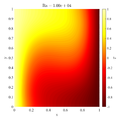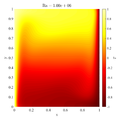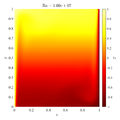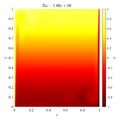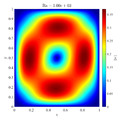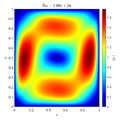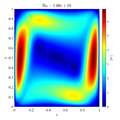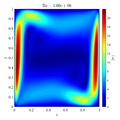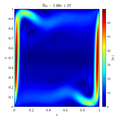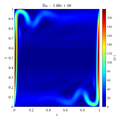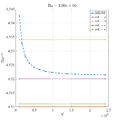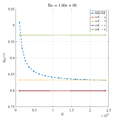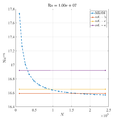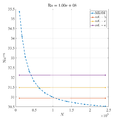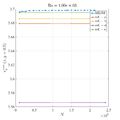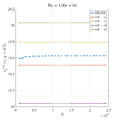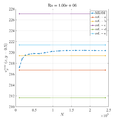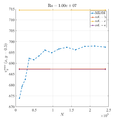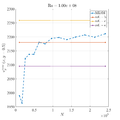De Vahl Davis natural convection test
Click here to return back to Fluid Mechanics
Contents
Intro
The classical de Vahl Davis benchmark test is defined for the natural convection of the air ($\Pr =0.71$) in the square closed cavity (${{\text{A}}_{\text{R}}}=1$). The only physical free parameter of the test remains the thermal Rayleigh number. In the original paper [1] de Vahl Davis tested the problem up to the Rayleigh number ${{10}^{6}}$, however in the latter publications, the results of more intense simulations were presented with the Rayleigh number up to ${{10}^{8}}$. Lage and Bejan [2] showed that the laminar domain of the closed cavity natural convection problem is roughly below $\text{Gr1}{{\text{0}}^{9}}$. It was reported [3, 4] that the natural convection becomes unsteady for $\text{Ra}=2\cdot {{10}^5}$. Here we present a MLSM solution of the case.
\begin{equation} \text{Ra}\text{=}\,\frac{\left| \mathbf{g} \right|{{\beta }_{T}}\left( {{T}_{H}}-{{T}_{C}} \right){{\Omega }_{H}}^{3}{{\rho }^{2}}{{c}_{p}}}{\lambda \mu } \end{equation} \begin{equation} \text{Pr}=\frac{\mu {{c}_{p}}}{\lambda } \end{equation}
[1] de Vahl Davis G. Natural convection of air in a square cavity: a bench mark numerical solution. Int J Numer Meth Fl. 1983;3:249-64.
[2] Lage JL, Bejan A. The Ra-Pr domain of laminar natural convection in an enclosure heated from the side. Numer Heat Transfer. 1991;A19:21-41.
[3] Janssen RJA, Henkes RAWM. Accuracy of finite-volume disretizations for the bifurcating natural-convection flow in a square cavity. Numer Heat Transfer. 1993;B24:191-207.
[4] Nobile E. Simulation of time-dependent flow in cavities with the additive-correction multigrid method, part II: Apllications. Numer Heat Transfer. 1996;B30:341-50.
Code
Full examples can be found under the examples in the code repository Main Page).
Explicit ACM method with CBS looks
1 v2[boundary] = vec_t{0.0, 0.0};
2 T2[left] = O.T_cold;
3 T2[right] = O.T_hot;
4 //Time stepping
5 for (int step = 0; step <= O.t_steps; ++step) {
6 for (int i_count = 1; i_count < _MAX_ITER_; ++i_count) {
7 // Navier Stokes
8 for (auto c : interior) {
9 v2[c] = v1[c] + O.dt * (-1 / O.rho * op.grad(P1, c)
10 + O.mu / O.rho * op.lap(v1, c)
11 - op.grad(v1, c) * v1[c]
12 + O.g * (1 - O.beta * (T1[c] - O.T_ref)));
13 }
14
15 //Speed of sound
16 Range<scal_t> norm = v2.map([](const vec_t& p) { return p.norm(); });
17 scal_t C = O.dl * std::max(*std::max_element(norm.begin(), norm.end()), O.v_ref);
18 // Mass continuity
19 Range<scal_t> div_v;
20 for (auto c:all) {
21 div_v[c] = op.div(v2, c);
22 P2[c] = P1[c] - C * C * O.dt * O.rho * div_v[c] +
23 O.dl2 * C * C * O.dt * O.dt * op.lap(P1, c);
24 }
25 P1.swap(P2);
26 }
27
28 //heat transport
29 for (auto c : interior) {
30 T2[c] = T1[c] + O.dt * O.lam / O.rho / O.c_p * op.lap(T1, c) -
31 O.dt * v1[c].transpose() * op.grad(T1, c);
32 }
33 for (auto c : top) T2[c] = op.neumann(T2, c, vec_t{0, -1}, 0.0);
34 for (auto c : bottom) T2[c] = op.neumann(T2, c, vec_t{0, 1}, 0.0);
35 }
Explicit pressure correction with fraction step scheme
The solution of heat equation is the same as in above example
1 for (int step = 0; step <= O.t_steps; ++step) {
2
3 // Explicit Navier-Stokes computed on whole domain, including boundaries
4 // without pressure -- Fraction step
5 for (int c:all) {
6 v_2[c] = v_1[c] + O.dt (
7 O.mu / O.rho * op.lap(v_1, c)
8 - op.grad(v_1, c) * v_1[c]
9 + O.g * (1 - O.beta * (T_1[c] - O.T_ref)));
10 }
11 // Pressure correction
12 VecXd rhs_pressure(N + 1, 0); //Note N+1, +1 stands for regularization equation
13 rhs_pressure(N) = 0; // = 0 part of the regularization equation
14 for (int i:interior) rhs_pressure(c) = O.rho / O.dt * op.div(v_2, c);
15
16 for (int i: boundary) rhs_pressure(c) = O.rho / O.dt * v_2[c].dot(domain.normal(c));
17 VecXd solution = solver_p.solve(rhs_pressure);
18 alpha = solution[N];
19 VecXd P_c = solution.head(N);
20 for ( int i = interior) v_2[c] -= O.dt / O.rho * op.grad(P_c, c);
21
22 v_2[boundary] = 0; // force boundary conditions
Results
Following video shows evolution of temperature and velocity magnitude for the $Ra=10^8$ case.
In below galley you can find temperature contour plots, velocity magnitude contour plots, v_max and average hot side Nusselt number convergence behavior. The reference values are from:
- [a] de Vahl Davis G. Natural convection of air in a square cavity: a bench mark numerical solution. Int J Numer Meth Fl. 1983;3:249-64.
- [b] Sadat H, Couturier S. Performance and accuracy of a meshless method for laminar natural convection. Numer Heat Transfer. 2000;B37:455-67.
- [c] Wan DC, Patnaik BSV, Wei GW. A new benchmark quality solution for the buoyancy-driven cavity by discrete singular convolution. Numer Heat Transfer. 2001;B40:199-228.
- [d] Šarler B. A radial basis function collocation approach in computational fluid dynamics. CMES-Comp Model Eng. 2005;7:185-93.
- [e] Kosec G, Šarler B. Solution of thermo-fluid problems by collocation with local pressure correction. Int J Numer Method H. 2008;18:868-82.


